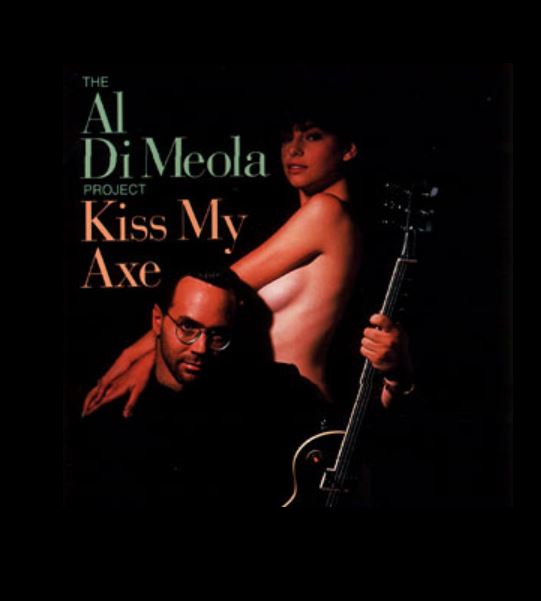The seductive pose the legendary Al Di Meola struck with a nude lovely on the sleeve of the superb “Kiss My Axe” album was probably essential marketing, as the appeal of the hot guitar player has never been so low. Di Meola-like players are rare, but it’s good to see Carlos Santana enjoying a revival, albeit a dubious one.
Santana is a virtuoso. Amidst the cacophony of the first Woodstock, which was jammed, much like its revival, with the musically inept, Carlos Santana shone. Here was this guy oblivious to all else but the Gibson, rendering a studio-perfect live performance, clearly about to take the blues scales where only Eddie Van Halen, Eric Clapton and the late great Stevie Ray Vaughan would tread, and sorry, no odes to Jimi Hendrix. A fine tunesmith and rhythm man, Hendrix’s picking was sloppy.
Music might be a matter of taste, but there is no relativism about technical merit. A career as a classical recitalist would be stumped were the musician’s fingers not sufficiently nimble to render Bach’s preludes and fugues. Or, as Glenn Gould put it: “Why do I play Bach so fast? Because I can.” And boy, could he. But this demand for “love of structure, clarity, complexity, nuance and imagination,” in the words of the “Times” art critic Robert Hughes, is rare in the pop and rock genres, and has been for some time.
Still, refrain we must from serenading the 1960s and 1970s. While well-crafted melodies were abundant during those years, there were not many worthy axemen, Santana, Van Halen, and Clapton excepted. (Incidentally, the only true headbanger of brilliance who won an indirect and posthumous Grammy was Igor Stravinsky for those mountains of sound, “The Rite of Spring” and “The Firebird” ballets.)
Santana’s “Supernatural” album is a collaborative calamity. It doesn’t hold a candle to “Marathon,” “Abraxas” or the first Santana vinyl gem showcasing the 16-year-old Mike Shrieve pounding the skins. Staging a comeback has meant losing the percussion-driven Latin distinctiveness. What remain are the haunting Santana riffs imposed upon crass, jarring pop tunes that jibe with the likes of Rob Thomas, Everlast or Lauryn Hill. This is the Zeitgeist’s recipe for success.
A recipe that is echoed with less competency in the discordance of “Limp Bizkit,” “Smashing Pumpkins,” or “Pearl Jam.” Listening to musical scaffolding that consists of shoddily executed three chords accompanied, in most cases, by two-note vocal melodies has meant enduring Workers Compensation Board-worthy mental anguish!
Wide Mouth Mason’s percussionist demonstrates he can barely managed an eighth-note rhythm and that with absolute zero variation. For his part, the guitarist in the band responds with simple strumming, shunning rhythmic variation. Deep breathing technique helped me get down with “The Tragically Hip” and the song “What’s to become of Us”. Their audile output? The minimalist three chords and a simple drum roll to punctuate the otherwise-routine drumming. Rhythmically and melodically the sum total is “Bah Bah Black Sheep.”
Singer Sarah McLachlan audaciously claims that her sound had its roots in the music of Cat Stevens. In the genre of pop music, Cat Stevens was gifted. His songs embody rather complex arrangements entirely absent from McLachlan’s warbles, which have no melodic progression. On she drones and six CDs later she and her Lilith bosom buddies are still belting the equivalent of “Three Blind Mice”: monotonous phrases, characterized by little harmonic resolution, and punctuated with a spasm of yodeling.
Listen to the Canadian band “Rush” and you hear harmonic complexity. Interesting chord changes and walking bass-lines combine with the kind of time signature fluctuations that require high-level musicianship and years of practice. Such sonic variety is missing from McLachlan’s around-the-camp-fire singalongs, the notes of which are invariably sustained with a distortion pedal, blended into a poorly articulated mess, and superimposed on a drumbeat bereft of fills.
The true finger blistering, almighty Fender-benders remain in the musical closet. These are the neo-classical instrumentalists, and in particular Tony MacAlpine, Yngwie Malmsteen, Eric Johnson, Vinnie Moore, Steve Morse and, of course, Sean Mercer. Recordings of their furious licks will be missing from the stores and the airwaves, so long as consumers are willing to pay for stuff that sounds as if it was produced after three lessons with a bad tutor.
Since the “Queensryche” lads have opted to stray from their classic sound and sophistication, I’m putting in a request for the return of the band’s older incarnation. (Was there ever a metal ballad lovelier than “Silent Lucidity”?) For good measure, why not throw in the outstanding Dann Huff who played me to pulp with “I’m a believer” on the memorable album “Giant.”
©2000 Ilana Mercer
The Calgary Herald
February 29

 print
print